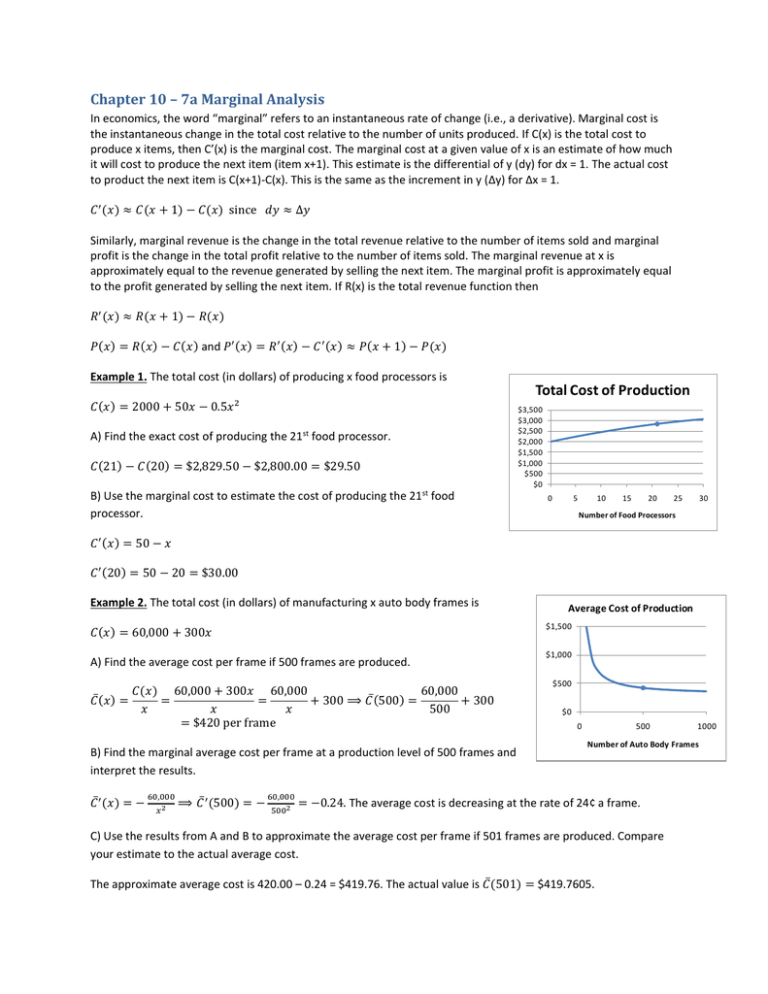Handout10-7aDone
advertisement

Chapter 10 – 7a Marginal Analysis In economics, the word “marginal” refers to an instantaneous rate of change (i.e., a derivative). Marginal cost is the instantaneous change in the total cost relative to the number of units produced. If C(x) is the total cost to produce x items, then C’(x) is the marginal cost. The marginal cost at a given value of x is an estimate of how much it will cost to produce the next item (item x+1). This estimate is the differential of y (dy) for dx = 1. The actual cost to product the next item is C(x+1)-C(x). This is the same as the increment in y (Δy) for Δx = 1. 𝐶 ′ (𝑥) ≈ 𝐶(𝑥 + 1) − 𝐶(𝑥) since 𝑑𝑦 ≈ ∆𝑦 Similarly, marginal revenue is the change in the total revenue relative to the number of items sold and marginal profit is the change in the total profit relative to the number of items sold. The marginal revenue at x is approximately equal to the revenue generated by selling the next item. The marginal profit is approximately equal to the profit generated by selling the next item. If R(x) is the total revenue function then 𝑅′ (𝑥) ≈ 𝑅(𝑥 + 1) − 𝑅(𝑥) 𝑃(𝑥) = 𝑅(𝑥) − 𝐶(𝑥) and 𝑃′ (𝑥) = 𝑅′ (𝑥) − 𝐶 ′ (𝑥) ≈ 𝑃(𝑥 + 1) − 𝑃(𝑥) Example 1. The total cost (in dollars) of producing x food processors is 𝐶(𝑥) = 2000 + 50𝑥 − 0.5𝑥 2 A) Find the exact cost of producing the 21st food processor. 𝐶(21) − 𝐶(20) = $2,829.50 − $2,800.00 = $29.50 B) Use the marginal cost to estimate the cost of producing the 21st food processor. Total Cost of Production $3,500 $3,000 $2,500 $2,000 $1,500 $1,000 $500 $0 0 5 10 15 20 25 30 Number of Food Processors 𝐶 ′ (𝑥) = 50 − 𝑥 𝐶 ′ (20) = 50 − 20 = $30.00 Example 2. The total cost (in dollars) of manufacturing x auto body frames is $1,500 𝐶(𝑥) = 60,000 + 300𝑥 A) Find the average cost per frame if 500 frames are produced. 𝐶̅ (𝑥) = 𝐶(𝑥) 60,000 + 300𝑥 60,000 60,000 = = + 300 ⟹ 𝐶̅ (500) = + 300 𝑥 𝑥 𝑥 500 = $420 per frame B) Find the marginal average cost per frame at a production level of 500 frames and interpret the results. 𝐶̅ ′ (𝑥) = − 60,000 𝑥2 ⟹ 𝐶̅ ′ (500) = − Average Cost of Production 60,000 5002 $1,000 $500 $0 0 500 1000 Number of Auto Body Frames = −0.24. The average cost is decreasing at the rate of 24¢ a frame. C) Use the results from A and B to approximate the average cost per frame if 501 frames are produced. Compare your estimate to the actual average cost. The approximate average cost is 420.00 – 0.24 = $419.76. The actual value is 𝐶̅ (501) = $419.7605. Example 3. The total profit (in dollars) from the sale of x skateboards is 𝑃(𝑥) = 30𝑥 − 0.3𝑥 2 − 250 0 ≤ 𝑥 ≤ 100 A) Find the approximate profit from the sale of the 25th skateboard and compare it to the actual profit. Approximate: 𝑃′ (𝑥) = 30 − 0.6𝑥 ⟹ 𝑃′ (24) = $15.60 Actual: 𝑃(25) − 𝑃(24) = 312.5 − 297.2 = $15.30 Total Profit $500 $300 $100 -$100 0 -$300 20 40 60 80 100 Number of Skateboards Sold B) Find the approximate profit from the sale of the 90th skateboard and compare it to the actual profit. Approximate: 𝑃′ (89) = −$23.40 Actual: 𝑃(90) − 𝑃(89) = 20 − 43.7 = −$23.70 Example 4. The total profit (in dollars) from the sale of x video DVDs is 𝑃(𝑥) = 5𝑥 − 0.005𝑥 2 − 450 Total Profit 0 ≤ 𝑥 ≤ 1,000 A) Evaluate the marginal profit at x = 450 and interpret the results. 𝑃′ (𝑥) = 5 − 0.01𝑥 ⟹ 𝑃′ (450) = $0.50. The total profit is increasing at the rate of 50¢ per DVD B) Evaluate the marginal profit at x = 750 and interpret the results. 𝑃′ (750) = −$2.50. The total profit is decreasing at the rate of $2.50 per DVD. $800 $600 $400 $200 $0 -$200 0 -$400 -$600 200 400 600 Number of DVDs 800 1000 Example 5. The demand (x units) for a clock radio depends on the price (p, in dollars) as given by Demand for Clock Radios Demand 4000 𝑥 = 4000 − 40𝑝 3000 2000 1000 0 $0 $20 $40 $60 $80 $100 Unit Price A) Find the price as a function of demand. What is the domain of this function? Solving the demand function for price: 𝑝 = 100 − 𝑥 40 0 ≤ 𝑥 ≤ 4000 Unit Price $100 $80 $60 $40 $20 $0 0 1000 2000 3000 4000 Number of Clock Radios B) Find the revenue, R(x), from the sale of x clock radios. What is the domain of this function? Total Revenue $100,000 𝑅(𝑥) = 𝑥𝑝(𝑥) = 100𝑥 − 𝑥2 40 $80,000 0 ≤ 𝑥 ≤ 4000 $60,000 $40,000 $20,000 $0 0 1000 2000 3000 4000 Number of Clock Radios Sold C) Find the marginal revenue at a production level of 1,600 clock radios and interpret the results. 𝑅′ (𝑥) = 100 − 𝑥 20 ⟹ 𝑅′ (1600) = $20. Total revenue is increasing at the rate of $20 per clock radio. Marginal Revenue $100 $50 $0 -$50 D) Find the marginal revenue at a production level of 2,500 clock radios and interpret the results. 𝑅′ (2500) = −$25. Total revenue is decreasing at the rate of $25 per clock radio. -$100 0 1000 2000 3000 Number of Clock Radios 4000









